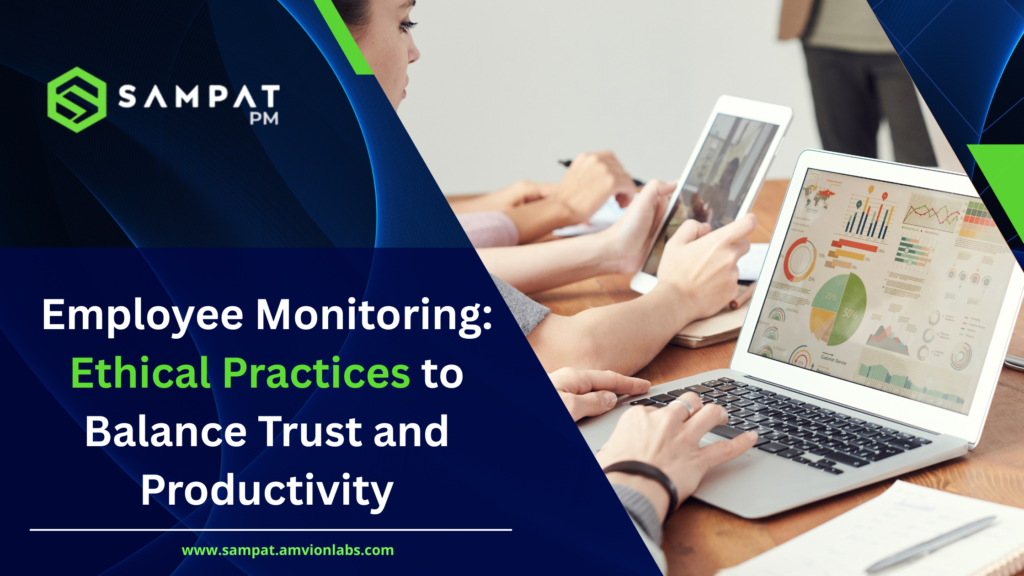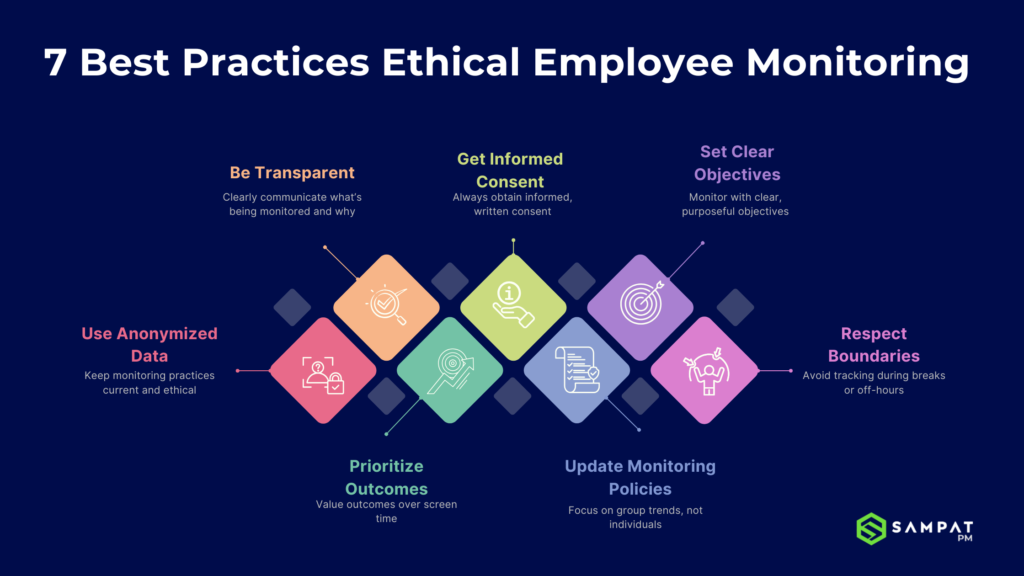
Employee Monitoring: Ethical Practices to Balance Trust and Productivity
Introduction: Why Ethics Matter in Employee Monitoring
In today’s hybrid and remote-first work culture, companies increasingly rely on employee monitoring software to gain visibility into workflows and performance. Whether it’s tracking computer activity, analyzing time spent on tasks, or monitoring attendance, these tools help businesses maintain operational efficiency.
But here’s the catch: Employee monitoring, when handled poorly, can lead to distrust, disengagement, and even legal challenges. So how can organizations strike the right balance between oversight and respect for privacy?
The answer lies in ethical monitoring practices—those that are transparent, justified, and focused on mutual benefits. This blog explores what ethical employee monitoring looks like and how to implement it without compromising on productivity or employee morale.
What is Employee Monitoring?
Employee monitoring involves utilizing various tools and technologies to track and document employees’ work-related activities. This may cover areas such as:
- Screen and keystroke tracking
- Email and communication logs
- Application and website usage
- Location tracking for mobile employees
- Time tracking and productivity analytics
Companies use this data to improve performance, ensure compliance, safeguard sensitive information, and optimize workflows.
However, monitoring becomes controversial when it crosses ethical boundaries, such as constant surveillance without consent or overstepping into personal activities.
That’s why the focus should not just be on “what” is being monitored but also on “how” and “why.”
The Importance of Ethics in Employee Monitoring
Ethical concerns around employee monitoring software are rooted in issues like privacy invasion, trust, lack of consent, and micromanagement. Employees may feel distrusted or stressed if they sense they’re being constantly watched.
Ethical monitoring ensures that tracking is:
- Transparency: It’s essential that employees are informed about what aspects of their work are being monitored, how the monitoring is conducted, and the reasons for it.
- Purposefulness: Monitoring should serve a clearly defined and beneficial objective, such as improving efficiency or protecting company data.
- Respect: The process must respect employees’ privacy and dignity, avoiding intrusive measures.
When organizations fail to uphold these standards, the consequences can be severe—ranging from employee dissatisfaction and high attrition to reputational harm and potential legal ramifications.
How Does Monitoring Employees Help the Organization?
Ethical employee monitoring can have a significant positive impact on overall business operations. Here are some major ways it benefits organizations:
1. Improves Productivity
Monitoring allows managers to identify time-wasting activities, workflow inefficiencies, or distractions that hinder performance. By addressing these challenges, organizations can boost output and streamline operations.
2. Strengthens Security
Monitoring software can detect unusual user behaviors that might indicate a cybersecurity threat. This proactive approach helps prevent data breaches and unauthorized access.
3. Ensures Policy Compliance
By tracking digital behavior, companies can ensure that employees follow company policies, industry regulations, and legal standards—especially in sectors like finance, healthcare, and law.
4. Optimizes Resource Allocation
When managers understand how time and tools are being used, they can better allocate resources—whether that means shifting workloads, training underperforming staff, or investing in better systems.
5. Enhances Accountability and Performance Reviews
Data from monitoring tools provides objective insights that support fair performance evaluations, goal tracking, and employee development.
6. Supports Remote Work Management
In remote or hybrid setups, employee monitoring helps maintain visibility into distributed teams, ensuring accountability while enabling flexibility.
7. Reduces Burnout and Overwork
By tracking workloads and hours, employers can detect when employees are working excessive hours or facing burnout risks, allowing for timely intervention.
Ultimately, monitoring—when done ethically—benefits both the organization and its workforce by promoting a culture of clarity, responsibility, and continuous improvement.
Ethical Employee Monitoring: 7 Best Practices
1. Be Transparent About Monitoring
The first rule of ethical monitoring is openness. Inform your team about:
- What will be monitored (e.g., websites, software, time spent)
- The tools being used (e.g., time tracking, activity reports)
- The reasons behind monitoring (e.g., improving efficiency, compliance)
Transparency fosters trust and reduces resistance to monitoring.
2. Obtain Informed Consent
Employees should consent to being monitored, especially in regions with strict data privacy laws like GDPR. Make sure they sign policies that outline monitoring practices in clear, jargon-free language.

3. Define Clear Objectives
Avoid blanket surveillance. Instead, focus on measurable goals like:
- Reducing time theft
- Improving resource allocation
- Ensuring cybersecurity
- Supporting performance reviews
Define what you want to achieve with employee monitoring software and communicate those goals.
4. Respect Personal Boundaries
Ethical monitoring respects that employees have personal lives, even during working hours. Don’t track activities outside work hours or on personal devices. Allow breaks and downtime without scrutiny.
5. Use Aggregated Data
Where possible, anonymize or aggregate data to evaluate team-level productivity trends instead of singling out individuals. This reduces the feeling of being constantly watched and avoids micromanagement.
6. Focus on Outcomes, Not Just Activity
Avoid equating productivity with busyness. Someone who works fewer hours may still produce higher-quality results. Shift from monitoring keystrokes or clicks to assessing the value delivered.
7. Review and Update Policies Regularly
Technology evolves—and so should your monitoring policies. Conduct regular audits to ensure your tools and practices align with ethical standards and legal regulations.
Benefits of Ethical Employee Monitoring
When done right, ethical monitoring helps everyone:
- Boost Productivity: Identify workflow bottlenecks and allocate resources more effectively.
- Enhance Security: Detect and prevent data leaks or non-compliant behavior.
- Improve Accountability: Employees stay aligned with responsibilities when expectations are clear.
- Support Work-Life Balance: Insight into workloads helps prevent burnout and overwork.
- Build Trust: Open communication and fair monitoring practices foster employee morale and strengthen engagement.

Pitfalls to Avoid in Employee Monitoring
Some common missteps include:
- Monitoring Without Notification: Secret surveillance creates a hostile environment.
- Over-Monitoring: Tracking every move leads to micromanagement and anxiety.
- Ignoring Feedback: If employees express concerns regarding monitoring practices, their input should be acknowledged and addressed.
- Using Monitoring for Punishment: It should be a tool for improvement, not control.
Avoiding these pitfalls ensures your monitoring strategy supports—not stifles—your workplace culture.
Legal and Compliance Considerations
Different countries and states have varying rules on what can be monitored. As an employer, it’s critical to:
- Stay updated on labor laws
- Provide written notice of monitoring
- Store data securely
- Offer access to monitored data if requested by employees
Consult legal counsel before deploying any new employee monitoring software.
How to Choose Ethical Employee Monitoring Software
Not every monitoring tool is designed with employee privacy and ethical use at its core. Choose software that offers:
- Customizable tracking features
- Consent and notification capabilities
- Role-based data access
- Real-time productivity dashboards
- Offline mode tracking (with limitations)
Platforms like SAMPAT offer ethical, productivity-focused solutions designed to balance efficiency and employee well-being.
Final Thoughts: Balance is the Key
Employee monitoring doesn’t have to mean spying—it can be an empowering tool for both employers and employees when done with empathy and transparency.
In today’s digital workspaces, productivity, accountability, and well-being must coexist. Ethical monitoring, backed by the right tools and intentions, ensures everyone wins.



